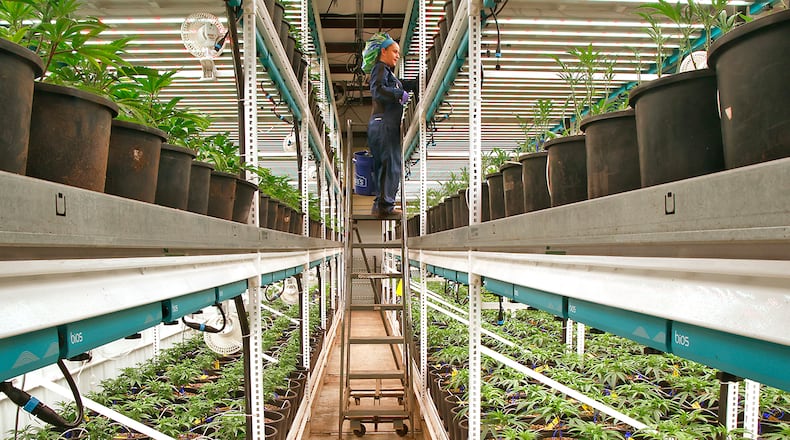But Tracey McMillin, chief operating officer of Springfield’s Pure Ohio Wellness, a statewide wholesaler that also directly supplies its two regional medical dispensaries, told this news organization that she has no concern about opening up dispensaries for recreational use.
“We’re for it. I think the faster we can give people what they asked for when they voted, I think the better off it is for everyone. We will do what we have to do to adjust,” McMillin said.
One possible adjustment to yield more marijuana is to build vertical racking systems as a workaround to the state’s regulations of how large cultivators can be by the square foot, something Pure Ohio Wellness is in the middle of doing. One stack of a vertical racking system can theoretically double that area’s production.
Already, Pure Ohio Wellness harvests anywhere from 150 to 450 pounds of flower a week.
As both a cultivator and dispenser, Pure Ohio Wellness can ensure it supplies its own stores before wholesaling its excess product and is relatively shielded from the dangers of too little supply and too much demand, which could be part of McMillin’s confidence.
Dispensary: ‘Sooner the better’
Sanjay Patel, managing member at Dayton’s Green Releaf Dispensary, also supports opening up the medical market to recreational sales sooner.
“If they could switch to recreational, the sooner the better,” he said.
Patel’s business is fully supplied by independent wholesalers like Pure Ohio Wellness.
“Everyone we talked to, they do think there would be an initial hiccup in terms of products not being available from everybody; but for us, inventory wise, we would be ready (given) the cultivators and the relationships we have with them. We’re pretty confident they’d be able to get us the products,” he said.
Credit: Bill Lackey
Credit: Bill Lackey
Both McMillin and Patel have also seen decreased demand in the medical market as recreational legalization has become a reality.
“(Lower medical demand) will absolutely hit more and more the closer we get (to recreational sales). Once it’s finalized, I think that’s when it will be really noticeable,” Patel said. “People are not going to be wanting to renew their cards, they’re having to pay the state, doctors and all of them money to renew cards when they’ll (soon) be able to just walk in. So why would you renew it?”
Green Releaf is one of over a dozen regional dispensaries that is caught in limbo following Ohio’s legalization of recreational marijuana and a subsequent quarrel over what the state ought to do to address the fact marijuana is now legal to possess, consume and grow but not purchase.
Legislative standstill
If Gov. Mike DeWine and the Ohio Senate had their way, Ohio’s current licensed medical marijuana dispensaries would begin selling recreational marijuana within 90 days to Ohioans 21 years of age or older. But the House, content to let Issue 2 take hold, is less eager to fix the problem for fear of straying too far from what voters overwhelmingly approved back in November.
With lawmakers on break, any fix remains at a standstill.
“The situation that we’re in now really doesn’t make a lot of sense,” DeWine told reporters last week at an end-of-the-year event at the Governor’s Mansion. He expressed disappointment in the House’s lack of urgency and asserted that, without legislative intervention, the quickest his administration could set up legal marijuana dispensaries would be anywhere from September to December of 2024.
DeWine worries that time frame will embolden Ohioans to buy from local dealers or continue giving Michigan marijuana tourism revenue. Or, Ohio could share a similar fate to New York, which after legalization saw a deluge of unlicensed pop-up shops selling seemingly legal marijuana in an illegal way.
As of right now, there’s no telling when the House might agree to a bill that allows medical dispensaries to open up. Leadership on both sides of the House aisle haven’t come out against the idea — like they have come out against reductions in THC content limits, reduction in home grow limits and large increases in the tax rate — but members have reiterated their interest in taking time to pass a solid, one-time reform to Issue 2 instead of a quick fix.
Montgomery County Rep. Tom Young, R-Washington Twp., told this news organization earlier this week that the House is “not in a rush to change anything at the moment.”
He continued, “However, access is really important. And as the governor has (said in) comments, we have a system already set up that can distribute THC products to individuals, so that may happen quicker than some of the other things.”
For DeWine, a resolution couldn’t come quick enough. “There’s a price to be paid for society every day the legislature waits to take action,” he said.
Follow DDN statehouse reporter Avery Kreemer on X or reach out to him at Avery.Kreemer@coxinc.com or at 614-981-1422.
About the Author



